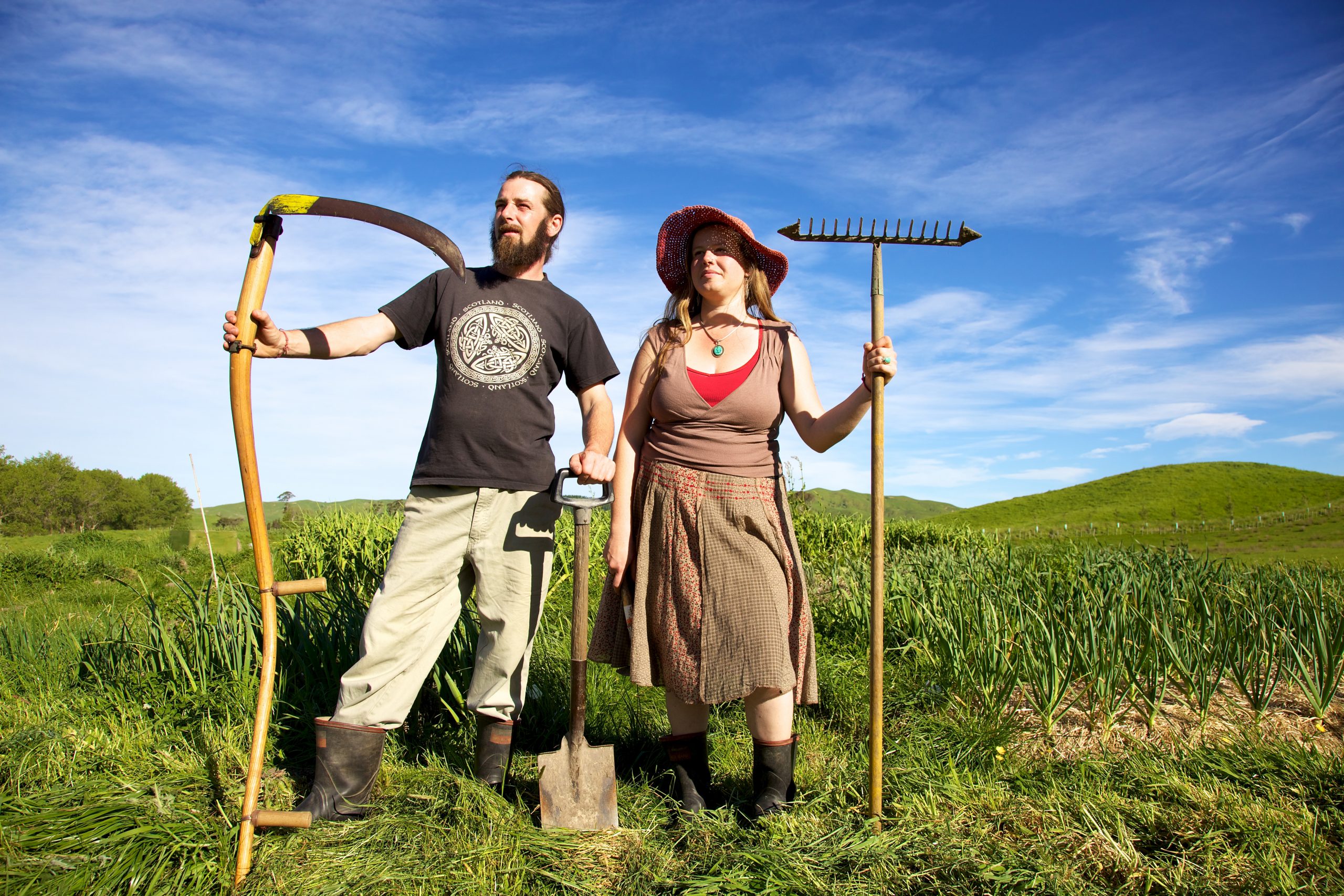Stumped as to what to do with your dud appliances? David Thompson goes hunting for answers and finds out that ultimately less is more.

If you’ve ever thrown out anything with a plug or battery in it, you’ve added to clean green New Zealand’s e-waste. Instead of being recycled or disposed of safely, virtually all of the 80,000 tonnes of our annual e-waste currently winds up in landfill. More sits in our garages – because we sense that biffing it is the wrong option, yet don’t know what the right ones are. There’s plenty that’s worrying about e-waste – but how can we be part of the solution?
E-waste is the world’s fastest-growing waste stream, according to the United Nations. One challenge is toxicity. If your old laptop, television or microwave ends up in the landfill, it’ll leach toxins into soil and water: lead, mercury, arsenic, cadmium, or ‘brominated flame retardants’ in plastics – name your poison. Such nasties are at the top end of toxicity.
Where e-waste ends up in unregulated destinations such as India, Pakistan or China, nimble-fingered labourers, sometimes children, dip circuit boards into acid baths to recover the gold. The rest gets open-burned, releasing carcinogens and neurotoxins into the air.
Under the Basel Convention, New Zealand undertakes to ship hazardous waste only to safety-compliant countries, but the onus to make sure this condition is satisfied is on individual exporters. (Our Environmental Protection Authority recommends considering all e-waste exports hazardous unless verified otherwise.)
Besides the problem of toxicity, e-waste squanders reusable, repairable or repurposable machines and recyclable materials. Every precious gram of metal buried is another gram that must be mined for the next device, and mining and manufacturing entails its own waste streams – not to mention guzzling energy and emitting greenhouse gases.
So what’s driving the insanity? Economically, the main culprit is a thing economists call ‘negative externalities’. It means the true cost of creating the latest electronic device isn’t falling on me – or the suppliers. It’s externalised to other people – carried by the child labourer, the environment, or the future. That sends false signals about just how expensive this e-stuff really is.
Due to the economics, turning this situation around will be challenging. One hurdle is that properly dismantling, separating and recovering the hundreds of materials in, say, a computer, costs more than the returns, meaning scant profits to lure private enterprise into the full business of safely recycling e-waste, or e-cycling.
Deceptively, the sales of ever-shinier devices push gross domestic product (GDP) up, not down, which makes our profligate shopping-and-tossing cycle look like progress. Suddenly the economic ideal of the ‘invisible hand’ – guiding individuals into choices benefiting all of society – is nowhere to be felt.
Meanwhile, other sinister forces are at work. Some manufacturers of modern products and appliances turn a nasty trick known as planned obsolescence. It’s where you deliberately design a product to have a limited life, because it’s more profitable to keep consumers churning through cheap replacements than for the manufacturer to release fewer, more durable models. In short, planned obsolescence is the opposite of the principle of ‘buy once, buy well’ and as Casey Harrell, head of Greenpeace International’s campaign on electronic waste agrees, it’s “the biggest issue”.
Vance Packard’s 1960 classic The Waste Makers: A Startling Revelation of Planned Obsolescence described a “systematic attempt of business to make us wasteful, debt-ridden, permanently discontented individuals”. But even if there’s no actual conspiracy at play, it’s clear that the big industry players are doing okay from how things are.
Planned obsolescence takes many forms: manipulation of fashion fads, drip-release of ever-fancier functionality, known incompatibility with upcoming software or withdrawal of support, and fragile, non-modular parts that can’t be replaced individually. All the while, tumbling prices drive product repairers out of business; try getting your toaster or fan heater fixed and you’ll quickly come up against this phenomenon.
Marketers might even hype the new releases as more eco-friendly. Remember when CDs were heralded as the end to throw-away tapes, and notice how e-readers are going to spare trees? But what matters is the turnover. Downsizing from desktop behemoths to handheld micro-miracles could slash our e-waste by volumes, and some genuinely cleaner, low-energy componentry now competes for the green dollar, but churning through so much of it, so much faster, undoes those gains.
So far, so depressing.

The good news, however, is that potential solutions exist all along the chain – from designing, to buying, to various ways of disposing of the product.
Consumer Power
Considerable power, and a fair amount of responsibility, rest with consumers. We can exert power upstream, through what we buy, and downstream, through how we dispose of it.
Wondering what you can do right now? You can spread the word to family and friends, offer to take back your neighbours’ e-waste with your own, or help guide purchasing and disposal decisions for a business, school or other organisation you’re involved with. Here are some ideas:
buy less & BETTER E-STUFF
Upstreaming means buying less, buying second-hand or refurbished (guarantees are often available) and choosing to replace less often.
When you do buy, check out green-purchasing advice from the Ministry for the Environment using the Electronic Product Environmental Assessment Tool.
Dipose of e-stuff less often & more creatively
Downstream, the options for general e-waste disposal multiply, and e-cycling is only one of them, albeit the simplest and safest one-stop shop.
E-cycling is unlike recycling paper, glass or plastic. Even a 2010 non-smart phone intricately compresses more technology, from longer global-supply chains, than that which was available only a short time ago. Safely undoing all that is as high-tech as assembling it, and requires economies of scale, meaning New Zealand doesn’t offer full e-cycling facilities.
For us, e-cycling refers to the earlier stages: collecting then refurbishing for on-sale or else dismantling, separating and shipping safely to specialised plants in larger, Basel-compliant countries such as Australia, Singapore and South Korea.
For TVs:
Drop off your old set during the Government’s TV TakeBack (a partnership with RCN e-Cycle, Project Green and Sims Recycling Solutions) when it rolls into a town near you.
You can personally:
- pay for repair or for parts replacement where possible, with a few of the dollars you saved by resisting the latest gadget
- re-sell working products to a trusted buyer
- donate working devices to organisations that agree to take them (the operative word being ‘agree’: cellphones to Starship Children’s Hospital – good; bag left outside the Salvation Army store overnight – bad)
- return to phones to Vodafone, Telecom or 2degrees

- contact the maker: some good corporate citizens take products back
- check out other refurbishers near you
- drop off to an occasional e-drive, run by your local council or volunteers
The key is ‘Disposer Beware’. Always ask: “What exactly will happen to my stuff?” And remember,whenever disposing of any electronic device, erase your data first.
Or use a one-stop shop
Alternatively, you can leave it all to the country’s only nationwide e-waste network, RCN e-Cycle. Approved by the Ministry for the Environment, and in collaboration with the Community Recycling Network and various councils and suppliers, it offers 50 collection sites across the country, which operate for a fee. Data is deleted and your items are refurbished and resold where possible,
and where it’s not, basic materials are recovered while the rest is dismantled and exported safely. Visit www.e-cycle.co.nz, or phone 0800 329 253, to arrange drop-offs, ongoing contracts, or even, sometimes, a pick-up. But watch this space: Project Green, with accredited local IT reseller RemarkIT, may well evolve from TV TakeBack to a full network for general e-cycling, and the Ministry for
the Environment hopes others will also emerge.
Best not to:
- take to landfill
- throw in a bin or skip (hazardous products are invariably banned anyway)
- put out for kerbside inorganic collections until you’ve checked your council’s advice on what is safe
It’s also best to avoid any rubbish remover or so-called recycler who can’t convincingly answer the question “What will you do with it?” No-one’s naming names, but many fly-by-nighters allegedly gut products for easy pickings such as copper then illegally dump or export the carcass.
What about long-term?
If we can’t rely on the invisible hand to guide appliance manufacturers to do the right thing, is Government providing any incentives?
The volunteer-run, government-subsidised eDays campaign, which ran from 2006 to 2010, was meant as a stop-gap while we embedded a habit and infrastructure of e-cycling, but no ongoing, unified solution has emerged.
In 2008, the Green Party-sponsored Waste Minimisation Act, governing all waste streams, passed near-unanimously and signalled broad recognition of the e-waste problem. The Act created the Waste Minimisation Fund, from a levy on landfill disposals. In the e-waste space, the fund spent $1.4 million helping to launch RCN e-Cycle, and it will spend up to $11.5 million on TV TakeBack, with more than $1 million so far going to Project Green.
Notably, half the levy goes to councils, and we may think of e-waste as their problem. Yet even Auckland Council, while “required by law to promote recycling options” has “no statutory responsibility for ensuring specific e-waste disposal and recycling services”. And it only controls 17 percent of its own region’s waste flows.
Nationwide, RCN e-Cycle was reportedly still getting only a paltry one percent of our total e-waste in 2012, even though all players agree the public generally want to do the right thing.
TV TakeBack aside, such poor uptake of so many initiatives suggests solutions have been haphazard, confusing, under-financed and under-publicised.
RCN chief Jon Thornhill and others want a firmer central government hand, with industry involvement to: co-ordinate; monitor and enforce a structure; gather hard stats; and underwrite an unprofitable but vital societal function.
Meanwhile, Laurence Zwimpfer, MNZM, an engineer with public policy training who leads the ongoing eDay New Zealand Trust (although no more eDays are planned), advocates a “product stewardship scheme”.
The 2008 Waste Minimisation Act provides the architecture for this overseas solution, which has been embraced by Zwimpfer, Thornhill, Project Green’s project manager Matthew Johnson and the Green Party.
The Ministry for the Environment calls these ‘cradle-to-grave’ arrangements “where producers, brand owners, importers, retailers, consumers and other parties accept responsibility for the environmental effects of their products”. As always, the devil is in the detail.
Zwimpfer, for one, dismisses any stewardship scheme involving a fee-at-disposal. He insists e-cycling must be free at the weakest link in the chain. You can’t rely on millions of consumers finding a safe e-cycler and delivering their junk – if they’re also paying for the privilege.
Because New Zealand lacks mega producers, both Zwimpfer and Thornhill want to levy importers – a small group who can’t readily dodge the fee. Accredited and accountable e-cyclers could then be paid by this fund.
This apparently neat solution would help deal with those problematic negative externalities. It would even tackle planned obsolescence by giving producers an incentive to design longer-lasting, less-wasteful products.
So far, the government has not initiated anything compulsory. It has invited voluntary stewardship organisations to tender for Waste Minimisation Funds and seek possible accreditation.
But Paul Bruce, of the Waste Forum, Wellington Region, echoes Zwimpfer and Thornhill in a remit proposed for the July conference of Local Government New Zealand. The proposal points out no voluntary schemes have come about for computer or TV equipment yet, calling on central government to co-regulate decisively with industry.
For, even where voluntary schemes do come forward, they are fragmented, unreliable, and too easy for non-members to free-ride. The proposal adds that removing fees-at-disposal is “critical”, and, finally, calls for a national ban on e-waste from landfill.
News from the suits
Minister for the Environment Amy Adams took her last computer to an e-drive. She believes in voluntary initiatives, a faith that is perhaps based on the eight that are already accredited (for different waste streams). Adams told Good, “I would prefer to see a producer-led solution to the e-waste problem,” but “if this is not forthcoming, or we aren’t seeing the right results, I am willing to consider mandatory options.” Encouragingly, she cites effective solutions overseas. And she sees TV TakeBack as building infrastructure and awareness.
Both Adams and critics want to continue co-operating with Australia, which already has infrastructure working under a Product Stewardship Act and enjoys economies of scale. The Ministry for the Environment told Good its biggest step since 2011 had been strengthening trans-Tasman e-waste standards.
The future of e-stuff
Tilting costs towards producers would apply the principle that solutions work better further up the chain. Otherwise, every extra link adds losses.
Likewise, consumers wield more power upstream than downstream. Cutting consumption beats e-cycling hands down; e-cycling is vital but it’s complex and costly.
Eminent German design chemist Michael Braungart has had some clever ideas on the subject. Whereas ‘cradle-to-grave’ implies we still end up burying stuff, ‘cradle-to-cradle’ envisages returning everything from the technosphere to the technosphere, and everything from the biosphere to the biosphere.
The idea is to design products to be biodegradable wherever possible, using the latest clean technologies, and reusing components of the rest to make future e-devices.
Until producer and importer levies are imposed, it remains mostly up to us as consumers. The best options at present? Reduce, reuse, e-cycle; but above all, reduce.
Going digital
It’s a little-known fact that even ancient television sets can, at some expense, be fitted out to pick up the new signal – as demonstrated by a high-profile quest to find and upgrade New Zealand’s oldest working telly – a 53-year-old model belonging to a 92-year-old from Hokitika. However, many of us, myself included, were long ago seduced by a digital-ready model.
In preparation for the region-by-region switch-off of the analogue television signal, the Ministry for the Environment has been rolling out TV TakeBack. They anticipate collecting around 500,000 old tellies along the way. With up to $11.5 million of Government cash, this scheme partners with RCN e-Cycle, Sims Recycling Solutions, and the specially created Project Green led by RemarkIT.
Some players accept TVs before the official timetable, but the full programme should reach the upper North Island for its last leg from October. Many councils and retailers are involved.
To find out if you’re already receiving the digital signal successfully, or how to re-equip an old set, visit www.goingdigital.co.nz. For where and when to dispose of a TV, see www.tvtakeback.govt.nz.
And for a limited time in each region, the cost of disposal will be cut from about $25 to $5. So get in quick!
Even those of us who are ableto hammer a nail straight or tinker with the inner workings of a radio probably identify with the alienation of no longer knowing how everyday electronic devices work or how to fix them.
And just as environmentally thoughtful, ethically careful living nourishes the spirit, slowing down e-consumption is one way into the pervading calm and mindfulness of the Slow life at large.
Choosing to moderate our frantic e-consumption, and switch off the devices themselves at times, can help tune us into a more sustainable rhythm. Slow e-consumption can help feed the soul in the same way that Slow food beats fast food. And less consumerism, less churn, less expense, less relentless virtual connectivity – really may be more.







